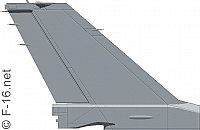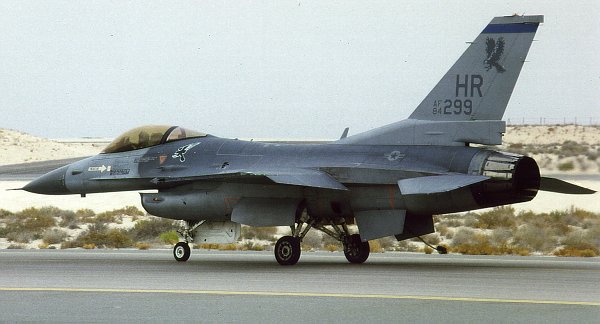 |
F-16C/Dblock 25 |
History
Production of the F-16C/D began with Block 25 (also known as MSIP Stage II). The first F-16C (serial number #83-1118) flew on June 19, 1984 and was delivered to the USAF one month later. The new variant was introduced on the production line in December. Flight testing of the new F-16C revealed problems, most of which were associated with software difficulties. Development lead times which were once paced by hardware problems were now becoming paced by software bugs, and there was a shortage of people which understood both computers and airplanes.
Following initial deliveries to overseas units, the 312st TFTS stationed at Luke AFB in Arizona became the first continental US unit to receive the F-16C/D, getting its first planes in April of 1986 and becoming fully operational in October of 1988.
The Block 25 F-16C/D aircraft were originally all powered by the Pratt & Whitney F100-PW-200 turbofan, but they have since been upgraded to the -220E standard.
Structure & Avionics
The implementation of the MSIP Stage II changes in the F-16 production line, resulted in the second generation of F-16 aircraft. Starting with Block 25, the F-16C and F-16D (as the one-seat and two-seat variants were designated) featured several improvements:
- Northrop Grumman ESSD (previously known as Westinghouse) AN/APG-68(V) radar, offering increased range, expanded operating modes, improved ECCM capability and sharper resolution. The AN/APG-68(V) is a considerable advancement over the APG-66 of the F-16A/B. The planar array in the nose provides numerous air-to-air modes, including range-while-search, uplook and velocity search, single target track, raid cluster resolution, and track-while-scan for up to 10 targets. Beyond-visible-range capability has been added in the form of a high-PRF track mode to provide continuous-wave (CW) illumination for guidance of the AIM-7 Sparrow semi-active radar homing missile. For air-to-ground work, the modes that are available include maritime, fixed and moving target, ground mapping, Doppler beam sharpening, ranging, beacon, and target freeze. The beacon mode is used for navigation fixes and for bombing offset. The maritime modes include a real beam mapping, sea search, fixed target track, and ground moving target indication and track. There is also a freeze mode. The fixed ground target modes include a real beam ground mapping mode, FTT mode, expanded display mode, and Doppler beam sharpening mode. The moving ground target modes include real beam ground mapping, GMTI or TMTT, expanded display, and freeze.
- Glass cockpit, featuring two MFD's and a GEC Marconi Avionics wide-angle holographic HUD, up-front controls, FLIR video and a Fairchild mission data transfer unit.
- Increased capacity environmental control and electrical power systems.
- MIL STD-1760 data bus/weapons interface allowing the use of AGM-65D Maverick and AIM-120 AMRAAM missiles.
- Improved fire control computer
- Improved stores management computer
- USAF-standard inertial navigation system (INS)
- Radar altimeter
- Anti-jam UHF radio
Externally, the F-16C is almost identical to the F-16A. The only significant external difference is the introduction on the F-16C of an enlarged triangular base or "island" on the rear fuselage leading up to the vertical fin, with a small blade antenna protruding upward from it. This extra space was originally intended to house the Westinghouse/ITT AN/ALQ-165 ASPJ (Airborne Self-Protection Jammer) that is used on Navy aircraft. The USAFs ASPJ program became mired in controversy in 1989-90, followed by the USAF's withdrawal from the project in January 1990. As a result, the ASPJ was never fitted in USAF F-16s.
Modifications & Upgrades
ANG and AFRC F-16C/D's are scheduled to be equipped with the Termal/Per Udsen PIDS (Pylon Integrated Dispenser System), Terma Elektronik's EWMS (Electronic Warfare Management System)
Production
A total of 209 block 25 C-models and 35 D-models have been delivered to the USAF. The USAF is the sole user of this block type. At the introduction of this model, regular Air Force units received it first. With the availability of the later block 30/40/50 models comming off the production line from 1986 onwards, all of these aircraft are now operational within ANG units.Specifications
Engine: One Pratt & Whitney F100-PW-220 turbofan, rated at 14,590 lb.s.t. dry and 23,770 lb.s.t. with afterburning.
Performance: Maximum short-endurance speed: Mach 2.02 (1333 mph) at 40,000 feet. Maximum sustained speed Mach 1.89 (1247 mph) at 40,000 feet. Tactical radius (hi-lo-hi interdiction on internal fuel with six 500-lb bombs) 360 miles. Maximum ferry range 2450 miles with maximum external fuel.
Dimensions: wingspan 31 feet 0 inches, length 49 feet 4 inches, height 16 feet 8 1/2 inches, wing area 300 square feet.
Weights: 18,238 pounds empty, 26,463 pounds normal loaded (air-to-air mission), 42,300 pounds maximum takeoff.
Please use this form to add any list any error or omissions you find in the above text.
Note: your comments will be displayed immediately on this page. If you wish to send a private comment to the webmasters, please use the Contact Us link.

